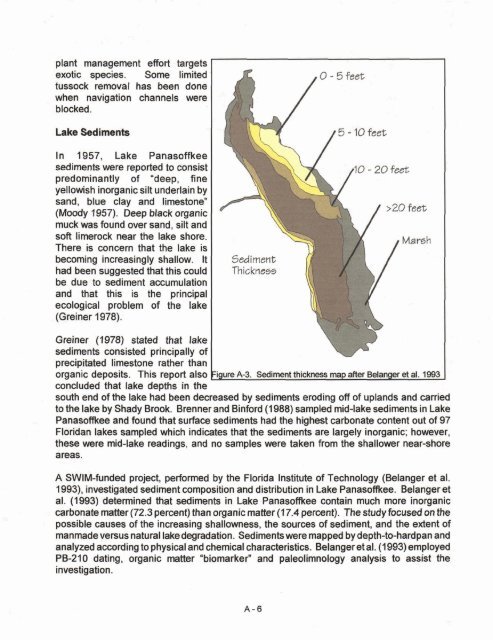Lake Panasoffkee SWIM Plan - Southwest Florida Water ...
Lake Panasoffkee SWIM Plan - Southwest Florida Water ...
Lake Panasoffkee SWIM Plan - Southwest Florida Water ...
Create successful ePaper yourself
Turn your PDF publications into a flip-book with our unique Google optimized e-Paper software.
plant management effort targets<br />
exotic species. Some limited<br />
tussock removal has been done<br />
when navigation channels were<br />
blocked.<br />
<strong>Lake</strong> Sediments<br />
In 1957, <strong>Lake</strong> <strong>Panasoffkee</strong><br />
sediments were reported to consist<br />
predominantly of "deep, fine<br />
yellowish inorganic silt underlain by<br />
sand, blue clay and limestone*<br />
(Moody 1957). Deep black organic<br />
muck was found over sand. silt and<br />
soft limerock near the lake shore.<br />
There is concern that the lake is<br />
becoming increasingly shallow. It<br />
had been suggested that this could<br />
be due to sediment accumulation<br />
and that this is the principal<br />
ecological problem of the lake<br />
(Greiner 1978).<br />
.<br />
Sediment<br />
Thickness<br />
/<br />
5 - 10 feet<br />
00 - 20 feet.<br />
Greiner (1978) stated that lake<br />
sediments consisted principally of<br />
precipitated limestone rather than<br />
organic deposits. This report also igure A-3. Sediment thickness map after Belanger et al. 1993<br />
concluded that lake depths in the<br />
south end of the lake had been decreased by sediments eroding off of uplands and carried<br />
to the lake by Shady Brook. Brenner and Binford (1988) sampled mid-lake sediments in <strong>Lake</strong><br />
- <strong>Panasoffkee</strong> and found that surface sediments had the highest carbonate content out of 97<br />
<strong>Florida</strong>n lakes sampled which indicates that the sediments are largely inorganic; however,<br />
these were mid-lake readings, and no samples were taken from the shallower near-shore<br />
areas.<br />
A <strong>SWIM</strong>-funded project, performed by the <strong>Florida</strong> Institute of Technology (Belanger et al.<br />
1993). investigated sediment composition and distribution in <strong>Lake</strong> <strong>Panasoffkee</strong>. Belanger et<br />
al. (1993) determined that sediments in <strong>Lake</strong> <strong>Panasoffkee</strong> contain much more inomanic<br />
carbonate matter (72.3 percent) than organic matter (17.4 percent). he study focused on the<br />
~0Ssible causes of the increasina shallowness. the sources of sediment. and the extent of<br />
knmade versus natural lakedegradation. ~edihents were mapped by depth-to-hardpan and<br />
analyzed according to physical and chemical characteristics. Belangeret al. (1993) employed<br />
PB-210 dating, organic matter "biomarker" and paleolimnology analysis to assist the<br />
investigation.
















